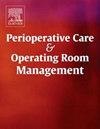竖脊肌阻滞、腰方肌阻滞和鞘内吗啡对剖宫产术后疼痛的镇痛效果比较:一项随机研究
IF 1
Q2 Nursing
Perioperative Care and Operating Room Management
Pub Date : 2025-09-12
DOI:10.1016/j.pcorm.2025.100552
引用次数: 0
摘要
背景:剖宫产后最佳镇痛仍然具有挑战性。在一项随机试验中,我们比较了竖脊肌平面阻滞(ESB)、腰方肌阻滞(QL)和鞘内吗啡(ITM)的疗效。方法将腰麻下剖宫产患者随机分为3组,每组40例。ITM组(高压布比卡因+ 150µg吗啡)、QL组(ITM + 0.25%布比卡因+地塞米松双侧ESB阻滞)、ESB组(ITM + 0.25%布比卡因+地塞米松双侧ESB阻滞)。主要观察指标为首次抢救镇痛的时间。次要结局包括疼痛评分(休息和运动时的NRS)、手术后24小时内镇痛药的用量、血流动力学变化、副作用和患者满意度。结果qlb组对首次镇痛要求的响应时间较ESB组和ITM组明显延长(分别为17.53±1.92 h、12.63±1.19 h、8.43±1.13 h), p < 0.001。与ITM和ESB组相比,QLB组镇痛剂量明显减少。与ITM相比,QLB组和ESB组在不同时间的休息和运动时的NRS疼痛评分明显较低。QLB组患者满意度最高。结论QL和ESB阻滞优于ITM单独阻滞,QL可能具有更好的内脏镇痛效果。本文章由计算机程序翻译,如有差异,请以英文原文为准。
Comparative analgesic efficacy of erector spinae block, quadratus lumborum block, and intrathecal morphine for post-operative pain relief after cesarean section: A randomized study
Background
Optimal post-cesarean analgesia remains challenging. We compared the efficacy of erector spinae plane block (ESB), quadratus lumborum block (QL), and intrathecal morphine (ITM) in a randomized trial.
Methods
Patients undergoing cesarean delivery under spinal anesthesia were randomized to three groups 40 patients each. ITM group (hyperbaric bupivacaine + 150 µg morphine), QL group (ITM + bilateral QL block with 0.25 % bupivacaine + dexamethasone), ESB group (ITM + bilateral ESB block with 0.25 % bupivacaine + dexamethasone). The primary outcome was the time to first rescue analgesia. Secondary outcomes included pain scores (NRS at rest and on movement), the amount of analgesics consumption during the first 24 h following surgery, changes in hemodynamics, side effects, and patient satisfaction.
Results
QLB group provided a significantly longer time to the first analgesic request compared to both ESB and ITM (17.53 ± 1.92 h, 12.63 ± 1.19 h, 8.43 ± 1.13 h respectively), with p < 0.001. QLB group also resulted in a significantly lower number of analgesic doses compared to ITM and ESB groups. Numeric Rating Scale (NRS)pain scores at rest & on movement was significantly lower in the QLB and ESB group at various times compared to ITM. Patient satisfaction was highest in the QLB group.
Conclusion
QL and ESB blocks are superior to ITM alone, with QL potentially offering better visceral analgesia.
求助全文
通过发布文献求助,成功后即可免费获取论文全文。
去求助
来源期刊

Perioperative Care and Operating Room Management
Nursing-Medical and Surgical Nursing
CiteScore
1.30
自引率
0.00%
发文量
52
审稿时长
56 days
期刊介绍:
The objective of this new online journal is to serve as a multidisciplinary, peer-reviewed source of information related to the administrative, economic, operational, safety, and quality aspects of the ambulatory and in-patient operating room and interventional procedural processes. The journal will provide high-quality information and research findings on operational and system-based approaches to ensure safe, coordinated, and high-value periprocedural care. With the current focus on value in health care it is essential that there is a venue for researchers to publish articles on quality improvement process initiatives, process flow modeling, information management, efficient design, cost improvement, use of novel technologies, and management.
 求助内容:
求助内容: 应助结果提醒方式:
应助结果提醒方式:


